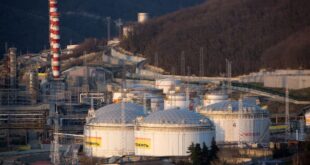Oil prices rose on Tuesday. lifted by healthy demand and output cuts led by producer group OPEC. although the gains were capped by the ongoing surge in U.S. supply while analysts warned of risks to the global economy. U.S. West Texas Intermediate (WTI) crude oil futures CLc1 were at $56.92 per barrel at 0636 GMT. up 13 cents. or 0.2 percent. from their last settlement. Reuters said. Brent crude futures LCOc1 were at $66.65 per barrel. up 7 cents. or 0.1 percent. Read alsoExpert warns about serious problems Ukraine will face after Nord Stream 2 completion Bank of America Merrill Lynch said despite economic headwinds `we still see Brent prices averaging $70 per barrel this year and expect WTI to lag. averaging $59 per barrel in 2019.` This was partly due to demand for marine diesel expected from next year as part of new fuel rules from the International Maritime Organization. it said. `With diesel yields already maxed out. refiners may need to lift runs in 2H19 to meet rising demand for marine distillates.` it said. Oil prices have been receiving broad support this year from supply cuts by the Organization of the Petroleum Exporting Countries (OPEC) and non-affiliated allies like Russia aimed at tightening markets. Saudi Arabia plans to cut its crude oil exports in April to below 7 million barrels per day (bpd). while keeping its output `well below` 10 million bpd. a Saudi official said on Monday. That compares to production of around 10.14 million bpd in February. Traders also pointed to the political and economic crisis in OPEC-member Venezuela as a driver for oil prices. Venezuela`s opposition-run congress on Monday declared a `state of alarm` over a five-day power blackout that has crippled the country`s oil exports and left millions of citizens scrambling to find food and water.

 Iran Energy News Oil, Gas, Petrochemical and Energy Field Specialized Channel
Iran Energy News Oil, Gas, Petrochemical and Energy Field Specialized Channel



